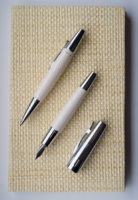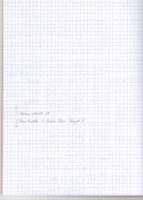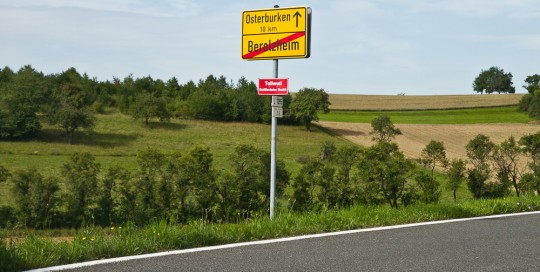A weekend in Shropshire
To celebrate my 40th birthday we spend the weekend in Shropshire …and of course I couldn’t resist buying more stationery.

Independent stationery shops
What a nice weekend it was – and I found an independent stationery shop in Shrewsbury – what a nice surprise. I hardly ever come across independent pen shops these days. The one where I live closed down and one in the town where I’m from closed down, too [1]There still one left in my home town, but it’s more of a post office / news agent / bit of everything shop.. I’d like to visit the Pen Company one day, but it’s several hours away. What’s left nearby is either focusing on art supplies or is part of a chain, which usually means that staff are not really excited about pens.
After buying some souvenir stationery in Shrewsbury Abbey I discovered Write Here. First: stocking up on Koh-I-Noor 1500 pencils – and then a fitting eraser from Koh-I-Noor as well.

Koh-I-Noor
In the 18th century Jospeh Hardtmuth started the pencil factory in Austria that would become Koh-I-Noor. Koh-I Noor is the name of a famous diamond. I seem to remember reading somewhere, probably in Petroski’s book, there were several pencils named after diamonds because diamonds and graphite both consist of carbon. In the 19th century manufacturing then moved to Bohemia, to Budweis in what is now the Czech Republic.
The Koh-I-Noor 1500, the pencil I bought, started being produced in 1889 [2]see Koh-I-Noor Hardtmuth’s history.. After WWII the factory, in what was then Czechoslovakia, was nationalised and Joseph Hardtmuth’s descendants started manufacturing in Austria again. A few years ago the Austrian ‘branch’ of the company went bankrupt and was taken over by Cretacolor, but the Czech ‘branch’ of the company does still exist under the Koh-I-Noor Hardtmuth name.
I have previously bought new old stock Koh-I-Noor 1500s in Shanghai and in my home town, but these are one of my few new ones. Too bad Write Here didn’t have HB and F (yes, you can get the 1500 in F), so I went for the B and H, which I’ve been using all of this week so far.

Write Here
Later that day I went back to Write Here, asking whether they have any fountain pens with flexible nibs. I’ve been looking for a nice fountain pen with a flexible nib for a long time now. My Lamy 2000 with an M nib and some of my Pelikan M200 nibs in F are quite flexible, but the line at its thinnest is too wide for me. Noodler’s nibs are nice and flexible, but when using any of my different Noodler fountain pens I usually end up having dirty hands because they spill ink after a while.
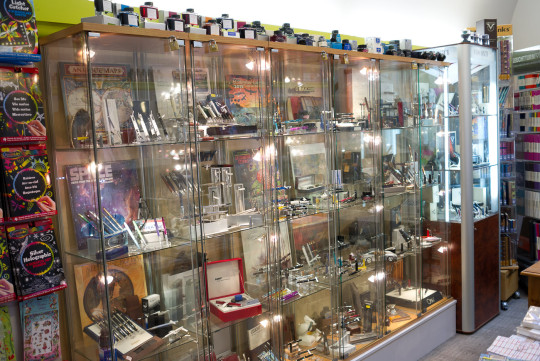
After asking for a pen with a flexible nib it took the owner of the shop a second to think about my request before taking a fountain pen out of his jacket and telling me to try it. What a nice, flexible nib that was. It was a fountain pen from Omas. I knew about Omas, but I never tried one before. When I started writing there was some feathering, but when I tried it on another paper the pen wrote smooth while still producing crisp lines. Unfortunately the pen was far too expensive for me. It turned out that this shop is also the distributor for Omas in the UK and I was told that very soon a cheaper pen with this nib will be released. I say cheaper, but it is still a £300 pen, which would make it more expensive than the most expensive pen I own.
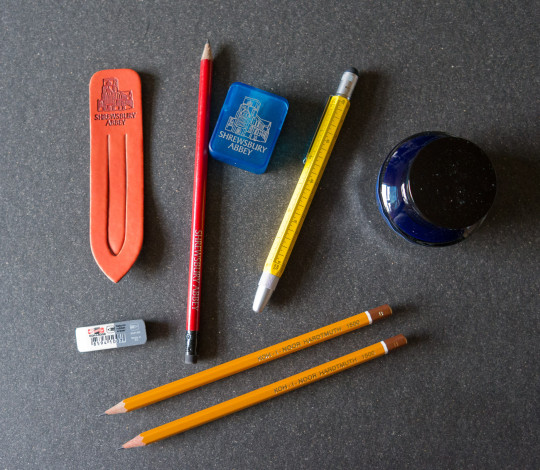
Pen and ink

I then bought the Monteverde Tool fountain pen – more in my price range, and the owner of the shop told me about Sailor’s pigment ink which contains nano pigments, so it doesn’t clog up the fountain pen.
I’m still not sure what to think about the fountain pen. It seems to skip quite a bit (using the cartridge that came with it), I hope that will get better over time. I also wonder why the scales on the pen incluse 1/200 metre and 1/300 metre. I have seen 1/x inch scales, but 1/x metre scales are certainly not very common and don’t seem to make much sense to me. Is this how imperial users imagine the metric system to work?
The ink can behave very well when used on good paper, but when I use it to fill in forms at work it feathers quite a bit. I think time will tell whether I like this ink, but so far I don’t think I’ll buy another bottle.
References
| ↑1 | There still one left in my home town, but it’s more of a post office / news agent / bit of everything shop. |
|---|---|
| ↑2 | see Koh-I-Noor Hardtmuth’s history. |
A weekend in Shropshire Read More »



